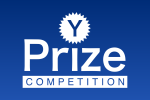 In Round 1 of the 2014-2015 Y-Prize Competition, a record number of 19 cross-disciplinary teams proposed creative applications for Penn nanotechnologies. Submissions included a video pitch and slide deck that the judges evaluated on market opportunity, value proposition, team strength, and execution plan. The finalists proposed uses for graphene, fast-charging batteries, and tunable adhesion that ranged from environmentally sustainable business solutions to counterfeit protection. One team even incorporated two of the three featured technologies into their proposal.
In Round 1 of the 2014-2015 Y-Prize Competition, a record number of 19 cross-disciplinary teams proposed creative applications for Penn nanotechnologies. Submissions included a video pitch and slide deck that the judges evaluated on market opportunity, value proposition, team strength, and execution plan. The finalists proposed uses for graphene, fast-charging batteries, and tunable adhesion that ranged from environmentally sustainable business solutions to counterfeit protection. One team even incorporated two of the three featured technologies into their proposal.
We are thrilled to announce this year’s finalists:
GFET-Frack Technologies
Ashwin Amurthur (W’15 & SEAS’15) and Teddy Guenin (W’15 & SEAS’15)
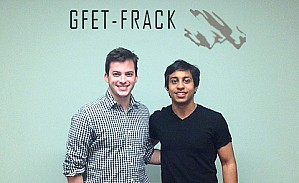 There are currently no effective ways for drilling companies to detect trace amounts of harmful leaked fracking fluid into groundwater at depths of around ~300ft. These leaks present themselves when pipeline casings splinter and crack during high-pressure fracking operations. GFET-Frack Technologies proposes to leverage the high sensitivity of graphene via field effect transistors for the specific detection of trace amounts of benzene, a common component of fracking fluid, in groundwater samples. Intensely accurate and reliable detection will enable drilling companies to ensure there is minimal contamination; that way, they can better inform their extraction partners of leaked casings (lost revenue and costly if undetected) while also helping municipalities ensure the viability of public groundwater reservoirs.
There are currently no effective ways for drilling companies to detect trace amounts of harmful leaked fracking fluid into groundwater at depths of around ~300ft. These leaks present themselves when pipeline casings splinter and crack during high-pressure fracking operations. GFET-Frack Technologies proposes to leverage the high sensitivity of graphene via field effect transistors for the specific detection of trace amounts of benzene, a common component of fracking fluid, in groundwater samples. Intensely accurate and reliable detection will enable drilling companies to ensure there is minimal contamination; that way, they can better inform their extraction partners of leaked casings (lost revenue and costly if undetected) while also helping municipalities ensure the viability of public groundwater reservoirs.
Lavoisier
Anastasia D’Orazio (WG’16), Ravit Dung (GEng’15), Matt McGuire (WG’16), and Meet Vora (GEng’15)
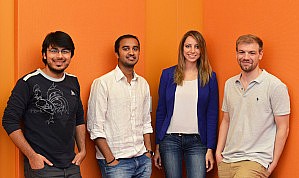 SafeStamp is a device and utility that combines graphene and quantum dots to ensure that a purchase is not counterfeit. When one shines a light on SafeStamp at a wavelength of a certain nanometer, a bright, glowing thumbs up appears. When the thumbs up is breathed upon, the light turns blue. The complicated nature of graphene production and quantum dot functionalization will ensure that SafeStamp won’t be replicated by counterfeiters.
SafeStamp is a device and utility that combines graphene and quantum dots to ensure that a purchase is not counterfeit. When one shines a light on SafeStamp at a wavelength of a certain nanometer, a bright, glowing thumbs up appears. When the thumbs up is breathed upon, the light turns blue. The complicated nature of graphene production and quantum dot functionalization will ensure that SafeStamp won’t be replicated by counterfeiters.
SolCharge
Sai Gali (GEng’15), Steph Gedal (SEAS’16), Roy Mathew (WG’16), and Earn Sakornpan (SEAS’16)
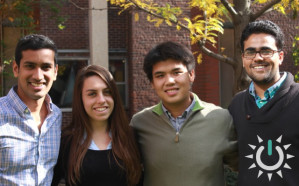 Solcharge is a sustainable, window attachable electronic charging device. It is powered by a fast-charging internal battery that harvests energy from solar panels. Solcharge can be used as an alternative to charge devices directly or by using energy previously stored by the battery. Our product features an innovative tunable adhesive lining around its circumference that makes it easy to stick and remove from any window. Small and portable, this device is aimed to provide the mobile workforce a viable alternative to charge their electronic devices while on the move.
Solcharge is a sustainable, window attachable electronic charging device. It is powered by a fast-charging internal battery that harvests energy from solar panels. Solcharge can be used as an alternative to charge devices directly or by using energy previously stored by the battery. Our product features an innovative tunable adhesive lining around its circumference that makes it easy to stick and remove from any window. Small and portable, this device is aimed to provide the mobile workforce a viable alternative to charge their electronic devices while on the move.
Thermophene
Bernardo Herrero (GEng’15), Weiyang Lim (GEng’15), Jonathan Mueller (WG’16), Diomedes Saldana (Gr’15), and Jing Yang (G’17)
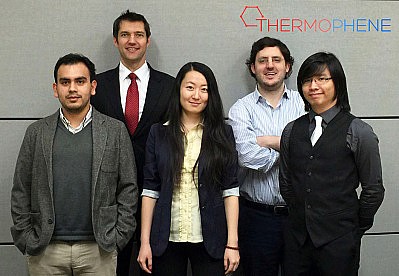 Thermophene sees graphene as the future of high-efficiency thermal management applications. Elevated operating temperatures limit the performance and operating life of electronics, and cost businesses and consumers $3B annually. The extraordinary thermal conductivity of graphene combined with recent advances in large-scale manufacturing, enable Thermophene to provide cost effective thermal management solutions to help customers handle their toughest thermal challenges. Thermophene aims to revolutionize the industry by creating solutions that productively meet customers’ current and future thermal management needs.
Thermophene sees graphene as the future of high-efficiency thermal management applications. Elevated operating temperatures limit the performance and operating life of electronics, and cost businesses and consumers $3B annually. The extraordinary thermal conductivity of graphene combined with recent advances in large-scale manufacturing, enable Thermophene to provide cost effective thermal management solutions to help customers handle their toughest thermal challenges. Thermophene aims to revolutionize the industry by creating solutions that productively meet customers’ current and future thermal management needs.
These teams will be paired up with tech and business consultants to continue refining their ideas over the next two months. They will pitch their proposed applications live to a panel of judges at the Y-Prize Finale on January 28th, 2015 for a grand prize of $5000 and licensing rights to the technology.
We offer a hearty congratulations to all entrants for their hard work and ingenuity!



